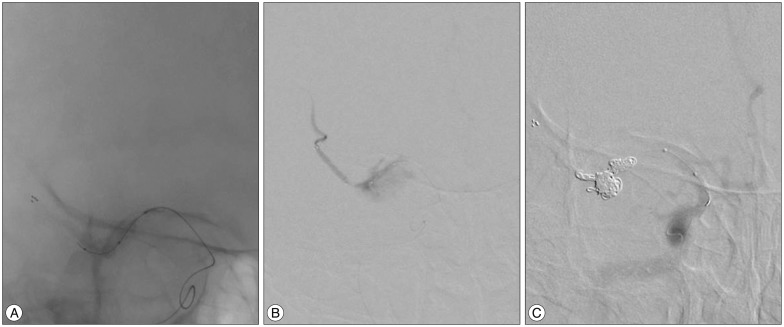J Korean Neurosurg Soc.
2014 Dec;56(6):463-468. 10.3340/jkns.2014.56.6.463.
Unexpected Detachment of Solitaire Stents during Mechanical Thrombectomy
- Affiliations
-
- 1Department of Neurosurgery, Busan Paik Hospital, Inje University, Busan, Korea.
- 2Department of Neurosurgery, Haeundae Paik Hospital, Inje University, Busan, Korea.
- 3Department of Diagnostic Radiology, Busan Paik Hospital, Inje University, Busan, Korea. hwjeong2000@lycos.co.kr
- 4Department of Neurology, Busan Paik Hospital, Inje University, Busan, Korea.
- 5Department of Neurology, Haeundae Paik Hospital, Inje University, Busan, Korea.
- 6Department of Diagnostic Radiology, S Pohang Hospital, Pohang, Korea.
- KMID: 2191131
- DOI: http://doi.org/10.3340/jkns.2014.56.6.463
Abstract
OBJECTIVE
Unexpected Solitaire stent detachment can occur during mechanical Solitaire thrombectomy. The purpose of this study was to retrospectively evaluate the influencing factors causing unexpected Solitaire stent detachment and the clinical outcomes.
METHODS
Between October 2011 to December 2013, 232 cases of mechanical Solitaire thrombectomy for acute ischemic stroke were performed in 3 stroke centers. During this period, we encountered unexpected Solitaire stent detachments during mechanical Solitaire thrombectomies in 9 cases.
RESULTS
Solitaire stents unexpectedly detached in 9 cases (3.9%) during the retrieval of Solitaire stents. The median patient age was 76 years. The occlusion sites of the unexpected stent detachment were the proximal middle cerebral artery (MCA) in 7 cases and the internal carotid artery in 2 cases. The sizes of the stents that unexpectedly detached were 6x30 mm in 7 cases, 5x30 mm in 1 case, and 4x20 mm in 1 case. Four patients had unexpected detachment at the first retrieval, 1 patient at the second, 3 patients at the third, and 1 patient at the fifth. In all of the cases of unexpected detachment at the first retrieval, the stent deployment site was the proximal MCA. After detachment, a proximal marker of the Solitaire stent was observed in 3 patients. However, no marker was visible in the remaining 6 patients.
CONCLUSION
Unexpected Solitaire stent detachment should be considered in the first instance of stent retrieval for a relatively large-diameter stent, especially in elderly patients with MCA occlusions.
Keyword
MeSH Terms
Figure
Reference
-
1. Dávalos A, Pereira VM, Chapot R, Bonafé A, Andersson T, Gralla J. Solitaire Group. Retrospective multicenter study of Solitaire FR for revascularization in the treatment of acute ischemic stroke. Stroke. 2012; 43:2699–2705. PMID: 22851547.
Article2. Dorn F, Stehle S, Lockau H, Zimmer C, Liebig T. Endovascular treatment of acute intracerebral artery occlusions with the solitaire stent : single-centre experience with 108 recanalization procedures. Cerebrovasc Dis. 2012; 34:70–77. PMID: 22759754.
Article3. Kang DH, Park J, Hwang YH, Kim YS. Inadvertent self-detachment of Solitaire AB stent during the mechanical thrombectomy for recanalization of acute ischemic stroke : lessons learned from the removal of stent via surgical embolectomy. J Korean Neurosurg Soc. 2013; 53:360–363. PMID: 24003371.
Article4. Kwon HJ, Chueh JY, Puri AS, Koh HS. Early detachment of the Solitaire stent during thrombectomy retrieval : an in vitro investigation. J Neurointerv Surg. 2014; 1. 16. [Epub]. http://dx.doi.org/10.1136/neurintsurg-2013-010942.5. Mokin M, Dumont TM, Veznedaroglu E, Binning MJ, Liebman KM, Fessler RD 2nd, et al. Solitaire Flow Restoration thrombectomy for acute ischemic stroke : retrospective multicenter analysis of early postmarket experience after FDA approval. Neurosurgery. 2013; 73:19–25. discussion 25-26. PMID: 23719060.6. Nayak S, Ladurner G, Killer M. Treatment of acute middle cerebral artery occlusion with a Solitaire AB stent : preliminary experience. Br J Radiol. 2010; 83:1017–1022. PMID: 21088087.
Article
- Full Text Links
- Actions
-
Cited
- CITED
-
- Close
- Share
- Similar articles
-
- How to Escape Stentriever Wedging in an Open-cell Carotid Stent during Mechanical Thrombectomy for Tandem Cervical Internal Carotid Artery and Middle Cerebral Artery Occlusion
- The Limitations of Thrombectomy with Solitaire(TM) AB as First-line Treatment in Acute Ischemic Stroke: A Single Center Experience
- Safety and Efficacy of Mechanical Thrombectomy with Solitaire Stent Retrieval for Acute Ischemic Stroke: A Systematic Review
- Adjuvant Tirofiban Injection Through Deployed Solitaire Stent As a Rescue Technique After failed Mechanical Thrombectomy in Acute Stroke
- Refinement of a Thrombectomy Technique to Treat Acute Ischemic Stroke: Technical Note on Microcatheter Advance during Retrieving Self-Expandable Stent




